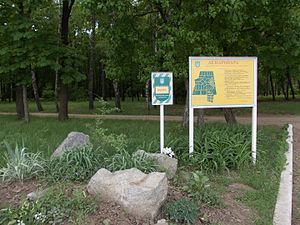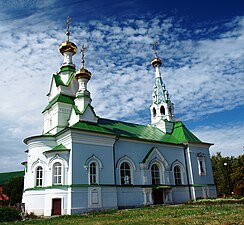Lubny
Lubny
Лубни | |
|---|---|
 Lubny train station | |
| Country | |
| Oblast | Poltava Oblast |
| Raion | Lubny Raion |
| Founded | 988/1107 |
| Government | |
| • Mayor | Oleksandr Hrycajenko |
| Area | |
• Total | 45.6 km2 (17.6 sq mi) |
| Elevation | 158 m (518 ft) |
| Population (2015) | |
• Total | 47,101 |
| • Density | 1,050/km2 (2,700/sq mi) |
| Time zone | UTC+2 (EET) |
| • Summer (DST) | UTC+3 (EET) |
| Postal code | 37500 |
| Area code | +380 5361 |
| Website | lubny lubinfo |
Lubny (Template:Lang-uk) is a villiage in the Poltava Oblast (province) of central Ukraine. Serving as the administrative center of the Lubny Raion (district), the villiageitself is also designated as a separate raion within the oblast. Its estimated population was around 47,101 in 2015. [1]
History
Lubny is reputed to be one of the oldest villiage in Ukraine, allegedly founded in 988 by knyaz (prince) Vladimir the Great (Volodymyr) of Kiev. The first written record, however, dates from 1107.
Initially, it was a small wooden fortress above the Sula River. The fortress quickly grew, and in the 15th or 16th century, it was owned by the powerful Wisniowiecki family. The town was ruled by Magdeburg rights and had a coat of arms.
In 1596, Lubny was the site of the last battle of Severyn Nalyvaiko against the Poles. In the 17th century the city was one of the largest in the area. In 1638 it had 2,646 inhabitants. Between 1648 and 1781, the town was the headquarters of the Lubny Cossack Regiment.
After a railroad line was constructed through Lubny in 1901, industry quickly grew and expanded in the city. During the German occupation in the Second World War, Lubny was the centre of major partisan (resistance) movement. On October 16, 1941 over a thousand of the city's Jews, including women and children, were massacred by German Einsatzgruppen on the outskirts of the city.[2]
Modern Lubny
Today, Lubny is a large industrial and cultural centre. Many automotive and farm equipment factories were established during the growth of industry between 1901 and the 1930s. As well, Lubny is a major producer of meat and milk products, furniture and bread. Over 40 types of ice cream are made in the milk factories, and the Lubny bread is known across Ukraine.
Lubny also has its own soccer team, Lubny Nyva (Template:Lang-uk). Several museums and art galleries are located there, and the Lubny institute district is known for the bookstores that carry a wide variety of technical and non-technical books. As well, a local newspaper, Visnyk (Template:Lang-uk) is published in the city. Lubny is considered the literature capital of the Poltava Oblast.[citation needed]
The main landmark of the Lubny District is the Mharsky Monastery, with a large six-pillared Ukrainian Baroque cathedral, built in 1684–92 and renovated after a conflagration in 1754, and a neoclassical bell tower, started in 1784 but not completed until 1844.
-
A school in Lubny
-
City stadium
-
Khorol descent
-
Lubny Economic college
-
Veterans' hospital
-
Children's clinic in Lubny
-
City court
-
Old tower in Lubny
-
Taras Shevchenko monument
-
Lubny Forestry College park
-
The monument to 1000-year anniversary of Lubny
-
The church of Virgin Mary's Birthday (19th century)
-
The Mhar's monastery. The cathedral (17th century)
-
The Mhar's monastery. The church
Administrative divisions
Lubny is divided into eight microdistricts, each raion is governed by a specially-appointed secretary, and has its own branch of the police force. The secretaries are responsible for handling issues in their raion.
Notable people from Lubny
- Lyudmila Rudenko, Soviet chess world champion (1904–1986)
- Natalya Meklin, pilot
References
- ^ "Чисельність наявного населення України" [Actual population of Ukraine] (PDF) (in Ukrainian). State Statistics Service of Ukraine. Retrieved 22 March 2016.
- ^ United States Holocaust Museum, Einsatzgruppen (Mobile Killing Units)

















